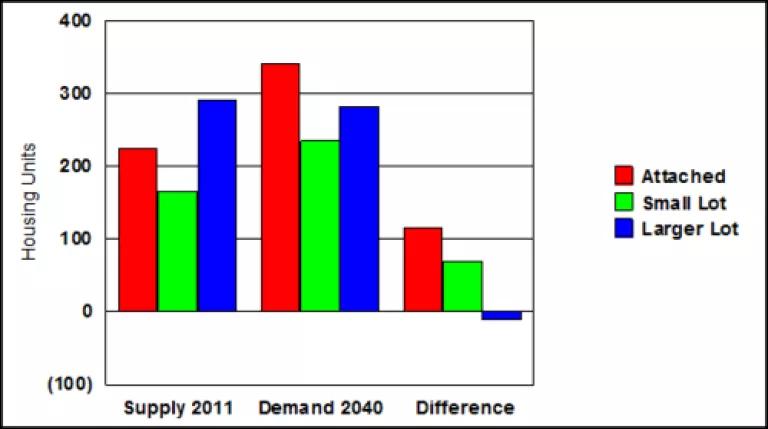
Choosing a home is one of the most important decisions we face in the United States. Rent or buy? Large or small? Yard or not? Location – urban, suburban, rural?
Demographics and economics drive these decisions, not just individually but aggregated for the U.S. And while it’s useful to examine projections for the nation, it’s even more useful to examine metropolitan regions. As I’ve written on these pages, regional plans for housing, transportation and land-use are important and oft-overlooked tools for looking ahead as we inevitably leap into a different future.
Fortunately, there are specialists who can help metropolitan planning organizations (MPOs) by analyzing projections to cross-reference with existing plans and help alter the latter accordingly (thanks to federal transportation law MPOs are required to develop long-range plans that span at least 20 years). One such specialist is Professor Arthur C. Nelson of the University of Utah.
I first saw Professor Nelson present demographic and housing professions to a rapt audience at a conference of thousands about a decade ago. He presented novel analysis of national projections showing the housing market would shift seismically, with growing demand for smart -growth development and shrinking demand for traditional suburban-sprawl-type development. Since then he has analyzed several metropolitan regional projections with similar results.
And now, thanks to NRDC’s Science Opportunity Fund, he applied his analytical method to Columbus’ metropolitan area. The findings are noteworthy and in some cases sobering in their consistency with the nation, perhaps not surprising since Columbus is enough of a microcosm to be a test market for corporate America.
Dr. Nelson finds Columbus is Ohio’s engine of growth. Amazingly, he says: “[I]f not for the Columbus MSA, Ohio would lose population from 2010 to 2030 as well as to 2040.”
Wow. Where is all this growth coming from?
First, the “new majority” (comprising all racial and ethnic minorities) will account for nearly all of it. This makes sense when we look back as well, as demographer William Frey of the Brookings Institution found when examining Census data from 1990-2010. Metro areas nationwide are changing so minorities are the majority in more and more cases, with Columbus alone dropping from 86 to 76 percent white.
Additionally, seniors account for a third of the population change. The Public Interest Research Group’s Phineas Baxandall has done yeoman’s work analyzing the national consequences for transportation of this so-called “silver tsunami,” as I covered here and here. One of the impacts on the housing market will be changes in the proportion of purchase vs. rental demand, with about half of seniors projected to become renters after selling their homes. An alarming upshot is that, barring marketplace transformation in light of the changing context there may be tens of thousands more seniors trying to sell their homes than there may be buyers of them.
Growth share by householder age, 1990–2010 and projected for 2010–2030
Such demographic changes underpin Professor Nelson’s finding that about 40% of the demand for new housing will be for attached and multifamily units and another 35% of the demand will be for smaller lots. The graph below illustrates this:

Of course, housing doesn’t change in isolation. Professor Nelson also examined commercial development, which will be very different in coming decades with increasing demand for smart-growth development. More than 1 billion square feet will be built, nearly equivalent to twice the volume of square feet supported in 2010, and 70% of that will be the redevelopment of existing spaces.
In a nutshell, as Professor Nelson puts it: “Technically, in Columbus all new jobs and all new multifamily housing could occur on existing parking lots.”
This stunning assessment alone makes Professor Nelsons’ recommendations for the region’s MPO (the Mid-Ohio Regional Planning Commission or MORPC) seem eminently reasonable:
- Regional agencies can use their information and education tools to elevate regional knowledge of the sweeping nature of demographic changes that will occur;
- Regional agencies should show the effects of different land use and transportation scenarios, being sure that extrapolation of the past is not an option.
- Regional education efforts can be used to show the benefits of improved housing choices, jobs-housing balance, and other benefits of improved regional distribution of development among local governments.
- There should be a modern regional transit system that connects key centers and other nodes along existing commercial corridors.
- The metropolitan planning organization should consider using some of its planning funds to help local governments engage in land-use and transportation planning that improves the regional distribution of growth and development.
- It should also use a portion of its federal transportation investment revenue to help implement those plans.
These steps may require serious changes in policy and practices in the region. Thankfully, “knowledge itself is power” as Francis Bacon wrote centuries ago. And thanks to Professor Nelson, regional leaders now have a powerful tool for preparing the region for an exciting and challenging housing future.
To check out the full study, click here.
